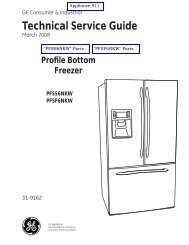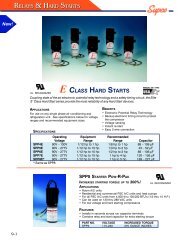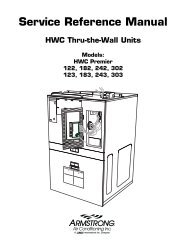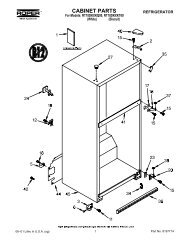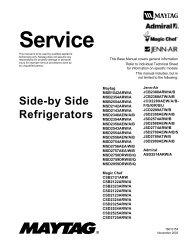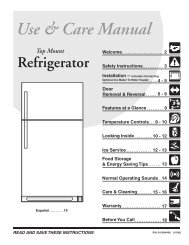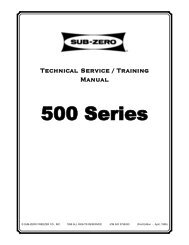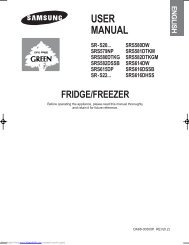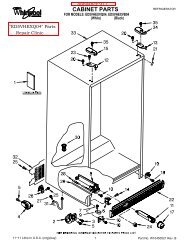ASD2620HE Amana Refrigerator Service Manual - Appliance 911 ...
ASD2620HE Amana Refrigerator Service Manual - Appliance 911 ...
ASD2620HE Amana Refrigerator Service Manual - Appliance 911 ...
You also want an ePaper? Increase the reach of your titles
YUMPU automatically turns print PDFs into web optimized ePapers that Google loves.
System Diagnosis<br />
CONDITION<br />
Refrigerant<br />
Overcharge<br />
Shortage of<br />
Refrigerant<br />
Partial<br />
Restriction<br />
Air in<br />
System<br />
Low Ambient<br />
Installations<br />
(High<br />
Ambients the<br />
Reverse)<br />
Additional<br />
Heat Load<br />
Inefficient<br />
Compressor<br />
SUCTION<br />
PRESSURE<br />
VARIATION<br />
FROM<br />
NORMAL<br />
HEAD<br />
PRESSURE<br />
VARIATION<br />
FROM<br />
NORMAL<br />
T1 INLET<br />
TEMPERATURE<br />
VARIATION<br />
FROM NORMAL<br />
T2 OUTLET<br />
TEMPERATURE<br />
VARIATION<br />
FROM NORMAL<br />
T3 SUCTION<br />
TEMPERATURE<br />
VARIATION<br />
FROM NORMAL<br />
WATTAGE<br />
VARIATION<br />
FROM<br />
NORMAL<br />
Increase Increase Warmer Warmer Colder Increase<br />
Decrease<br />
Decrease<br />
Decrease or<br />
Increase<br />
See Text<br />
Decrease or<br />
Increase<br />
See Text<br />
Note 2<br />
Colder Warmer Warmer Decrease<br />
Colder Warmer Warmer Decrease<br />
Near Normal Increase Warmer Warmer Warmer Increase<br />
Decrease Decrease Colder Warmer Warmer Decrease<br />
Increase Increase Warmer Warmer Warmer Increase<br />
Increase<br />
Normal or<br />
Decrease<br />
Warmer or<br />
Colder<br />
Symptoms of an Overcharge<br />
• Above normal freezer temperatures.<br />
Longer than normal or continuous run.<br />
Freezing in refrigerator, especially on forced air<br />
meatkeeper models.<br />
Higher than normal suction and head pressure.<br />
Higher than normal wattage.<br />
Evaporator inlet and outlet temperatures warmer than<br />
normal.<br />
Suction tube temperature below ambient. Always<br />
check for separated heat exchanger when suction<br />
temperature is colder than ambient.<br />
Various conditons could indicate an overcharge. For<br />
example, if the cooling coil is not defrosted at regular<br />
intervals, due to a failure of the defrost system, the<br />
refrigerant will "flood out" and cause the suction line to<br />
frost or sweat. The cause of this problem should be<br />
corrected rather than to purge refrigerant from the<br />
sytem. Running the freezer section colder than<br />
necessary (-2 to -1 F. is considered normal package<br />
temperatures) or continuous running of the compressor<br />
for a variety of reasons, or the freezer fan motor not<br />
running, may give the indication of an overcharge.<br />
Warmer Warmer Decrease<br />
Symptoms of Refrigeration Shortage<br />
Rise in food product temperature in both<br />
compartments. (See Note 1 below.)<br />
Long or continuous run time.<br />
Look for obvious traces of oil that would occur due to a<br />
leak or cracked refrigerant line.<br />
Lower than normal wattage.<br />
Compressor will be hot to touch because of the heat<br />
generated by the motor windings from long continuous<br />
running. It will not be as hot as it would be with a full<br />
charge and long run times for some other reason such<br />
as a dirty condenser.<br />
Depending on the amount of the shortage, the<br />
condenser will not be hot, but closer to room<br />
temperature. The capillary tube will be warmer than<br />
normal from a slight shortage.<br />
If the leak is on the high side of the system, both<br />
gauges will show lower than normal readings and will<br />
show progressively lower readings as this charge<br />
becomes less. The suction pressure guage will<br />
probably indicate a vacuum.<br />
If the leak is on the low side of the system the suction<br />
pressure guage will be lower than normal - probably in<br />
a vacuum - and the head pressure gauge will be<br />
higher than normal. It will probably continue to<br />
become higher because air drawn in through the leak<br />
is compressed by the compressor and accumulates in<br />
©2005 Maytag <strong>Service</strong>s 16025628 27




